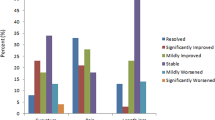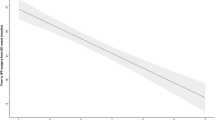Abstract
The objective of this study was to define the pattern and time course of use of ED treatments in a Veterans Affairs (VA) medical center and to identify clinical or demographic variables that are associated with the use of second- or third-line ED treatments. We identified 702 men treated for ED at the Greater Los Angeles Veterans Affairs between 2007 and 2013. We extracted demographics, Charlson co-morbidity score, pertinent surgical/medication history as well as use of ED treatments from medical records. On multivariate analysis, age over 65 (OR 1.83, 95% CI: 1.31–2.56) and Charlson co-morbidity score of 1 (OR 1.77, 95% CI: 1.13–2.77) and 2+ (OR 2.07, 95% CI: 1.28–3.36) were significantly associated with use of medicated urethral suppositories for erection (MUSE)/intracorporal injections (ICI) compared with PDE5i/erection devices. Across all men who used second- or third-line treatments, median time until receiving MUSE was 0.6 years and median time until receiving ICI/implant was 2 years. We conclude that men who will ultimately use more invasive ED treatments, such as men with more co-morbidities, tend to have a prolonged treatment course. This information may be incorporated into a shared decision-making model for more efficient treatment of ED.
This is a preview of subscription content, access via your institution
Access options
Subscribe to this journal
Receive 8 print issues and online access
$259.00 per year
only $32.38 per issue
Buy this article
- Purchase on Springer Link
- Instant access to full article PDF
Prices may be subject to local taxes which are calculated during checkout


Similar content being viewed by others
References
Shamloul R, Ghanem H . Erectile dysfunction. Lancet 2013; 381: 153–165.
Litwin MS, Nied RJ, Dhanani N . Health-related quality of life in men with erectile dysfunction. J Gen Intern Med 1998; 13: 159–166.
Smith WB, McCaslin IR, Gokce A, Mandava SH, Trost L, Hellstrom WJ . PDE5 inhibitors: considerations for preference and long-term adherence. Int J Clin Pract 2013; 67: 768–780.
Bernal RM, Henry GD . Contemporary patient satisfaction rates for three-piece inflatable penile prostheses. Adv Urol 2012; 2012: 707321.
Segal RL, Camper SB, Burnett AL . Modern utilization of penile prosthesis surgery: a national claim registry analysis. Int J Impot Res 2014; 26: 167–171.
Tal R, Jacks LM, Elkin E, Mulhall JP . Penile implant utilization following treatment for prostate cancer: analysis of the SEER-Medicare database. J Sex Med 2011; 8: 1797–1804.
Walsh TJ, Hotaling JM, Smith A, Saigal C, Wessells H . Men with diabetes may require more aggressive treatment for erectile dysfunction. Int J Impot Res 2013; 26: 112–115.
Charlson ME, Pompei P, Ales KL, Mackenzie CR . A new method of classifying prognostic comorbidity in longitudinal studies: development and validation. J Chronic Dis 1987; 40: 373–383.
Baniel J, Israilov S, Segenreich E, Livne PM . Comparative evaluation of treatments for erectile dysfunction in patients with prostate cancer after radical retropubic prostatectomy. BJU Int 2001; 88: 58–62.
Prabhu V, Alukal JP, Laze J, Makarov DV, Lepor H . Long-term satisfaction and predictors of use of intracorporeal injections for post-prostatectomy erectile dysfunction. J Urol 2013; 189: 238–242.
Acknowledgements
This study was funded by the UCLA Department of Urology.
Author information
Authors and Affiliations
Corresponding author
Ethics declarations
Competing interests
The authors declare no conflict of interest.
Rights and permissions
About this article
Cite this article
Clavijo, R., Daskivich, T., Kwan, L. et al. Time course and predictors of use of erectile dysfunction treatment in a Veterans Affairs medical center. Int J Impot Res 28, 167–171 (2016). https://doi.org/10.1038/ijir.2016.20
Received:
Revised:
Accepted:
Published:
Issue Date:
DOI: https://doi.org/10.1038/ijir.2016.20



